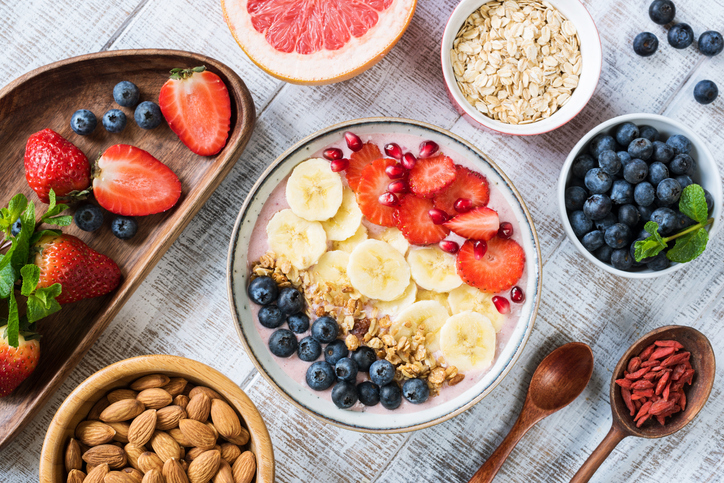
Snacking often gets a bad rap, conjured up as sneaky handfuls of chips or late-night ice cream binges. But what if snacking could be both delicious and good for you? Enter low calorie fruits—nature’s candy that satisfies your sweet tooth without derailing your health goals. I remember the first time I swapped my usual afternoon cookie for a bowl of juicy strawberries; it was a revelation! Not only did I feel lighter, but my energy didn’t crash an hour later. In this in-depth guide, we’ll explore the world of low calorie fruits, why they’re perfect for healthy snacking, and how to incorporate them into your daily routine. From nutritional benefits to creative recipes, we’ve got you covered with expert insights and practical tips to make snacking both fun and nutritious. Let’s dive in!
Why Low Calorie Fruits Are Snack Superstars
Fruits are a gift from nature—bursting with flavor, packed with nutrients, and often low in calories. Unlike processed snacks, which can be loaded with sugar and unhealthy fats, low calorie fruits offer a natural sweetness that satisfies cravings while nourishing your body. According to the Harvard T.H. Chan School of Public Health, fruits are rich in fiber, vitamins, and antioxidants, which support everything from heart health to glowing skin. When I started paying attention to my snack choices, I noticed how a handful of berries could keep me full longer than a granola bar, thanks to their high water and fiber content.
Low calorie fruits are particularly great for those watching their weight or managing conditions like diabetes. They provide a burst of energy without the calorie overload, making them ideal for anyone aiming to maintain a healthy lifestyle. Plus, they’re portable, versatile, and require little to no prep—perfect for busy days when you need a quick, guilt-free bite.
The Best Low Calorie Fruits for Snacking
Not all fruits are created equal when it comes to calorie content. Below, we’ll explore some of the best low calorie fruits that make snacking both delicious and nutritious. Each of these fruits is under 100 calories per serving, making them perfect for curbing hunger without tipping the calorie scale. Here’s a rundown of my favorites, backed by data from the USDA FoodData Central.
Strawberries: The Sweet and Tangy Delight
Strawberries are a snacker’s dream—sweet, juicy, and only about 50 calories per cup (150g). They’re loaded with vitamin C, which supports immune health, and antioxidants that fight inflammation. I love tossing a handful into my bag for a mid-morning pick-me-up. Pro tip: Pair them with a tablespoon of Greek yogurt for a creamy, protein-packed treat.
Blueberries: Tiny but Mighty
At roughly 85 calories per cup (148g), blueberries are a nutritional powerhouse. They’re rich in anthocyanins, antioxidants linked to improved brain health, as noted by the Mayo Clinic. I once made a habit of snacking on blueberries during work calls, and I swear my focus improved! Freeze them for a refreshing, popsicle-like snack on hot days.
Watermelon: Hydration in Every Bite
Watermelon is a hydration hero, with a cup (152g) clocking in at just 46 calories. Its high water content (92%) makes it incredibly filling, and it’s a great source of lycopene, which supports heart health. According to Healthline, watermelon can even aid post-workout recovery. Cube it up for a refreshing snack or blend it into a slushie for a fun twist.
Apples: Crunchy and Satisfying
An average medium apple (182g) has about 95 calories and is packed with fiber, which promotes satiety. The American Heart Association highlights fiber’s role in heart health and digestion. I love slicing an apple and spreading a thin layer of almond butter for a balanced snack that keeps me full for hours.
Clementines: Pocket-Sized Sweetness
Clementines are like nature’s candy, with one small fruit (74g) at just 35 calories. They’re rich in vitamin C and easy to peel, making them a convenient on-the-go snack. I keep a few in my desk drawer for those moments when I need a quick burst of sweetness. The Cleveland Clinic notes that vitamin C can boost mood, which I can attest to after a stressful day!
Raspberries: Fiber-Packed Gems
A cup of raspberries (123g) has about 64 calories and a whopping 8 grams of fiber—more than most fruits. This makes them incredibly filling, as fiber slows digestion. I learned this the hard way when I overindulged in raspberries and felt full for hours! They’re also rich in antioxidants, as per Medical News Today.
Comparison Table: Low Calorie Fruits at a Glance
To help you choose the perfect fruit for your snacking needs, here’s a comparison of the fruits mentioned above, based on a standard serving size.
Fruit Calorie and Nutrient Snapshot
| Fruit | Serving Size | Calories | Key Nutrients | Best For |
|---|---|---|---|---|
| Strawberries | 1 cup (150g) | 50 | Vitamin C, antioxidants | Quick, sweet snack |
| Blueberries | 1 cup (148g) | 85 | Anthocyanins, vitamin K | Brain health, frozen treat |
| Watermelon | 1 cup (152g) | 46 | Lycopene, hydration | Post-workout, summer refreshment |
| Apples | 1 medium (182g) | 95 | Fiber, vitamin C | Filling, versatile snack |
| Clementines | 1 small (74g) | 35 | Vitamin C, folate | On-the-go, mood booster |
| Raspberries | 1 cup (123g) | 64 | Fiber, antioxidants | Satiety, digestive health |
This table makes it easy to see which fruits fit your needs—whether you’re after hydration, fiber, or a quick energy boost. For example, if I’m heading to the gym, I grab watermelon, but for a desk-side snack, clementines are my go-to.
Creative Ways to Enjoy Low Calorie Fruits
Low calorie fruits are versatile enough to go beyond just eating them raw. Here are some creative ideas to make your snacks exciting, inspired by my own kitchen experiments and tips from EatingWell.
- Fruit Skewers: Thread strawberries, blueberries, and watermelon chunks onto skewers for a colorful, kid-friendly snack. Drizzle with a touch of honey for extra sweetness.
- Smoothie Bowls: Blend frozen raspberries and a banana with a splash of almond milk, then top with a sprinkle of chia seeds. It’s like dessert, but healthy!
- Fruit Salsa: Dice apples, strawberries, and clementines, then mix with a squeeze of lime juice and a pinch of cinnamon. Serve with whole-grain crackers for a crunchy twist.
- Frozen Fruit Pops: Puree watermelon or strawberries, pour into molds, and freeze for a refreshing treat. I made these for a summer BBQ, and they were a hit!
- Fruit-Infused Water: Add sliced clementines or berries to your water bottle for a naturally flavored drink that encourages hydration.
These ideas keep snacking fun and prevent boredom, which is key to sticking with healthy habits. Experiment with combinations to find your perfect mix!
Health Benefits of Low Calorie Fruit Snacks
Snacking on low calorie fruits isn’t just about cutting calories—it’s about fueling your body with nutrients that support long-term health. Here’s a deeper look at the benefits, backed by science and my own experience.
Weight Management
Low calorie fruits are naturally low in energy density, meaning they provide fewer calories per gram. A study from the Journal of Nutrition shows that incorporating low-energy-density foods like fruits can help with weight loss by increasing satiety. When I started snacking on apples instead of pretzels, I noticed I could eat more volume without feeling deprived.
Blood Sugar Control
For those managing diabetes or pre-diabetes, low calorie fruits like berries have a low glycemic index, meaning they don’t spike blood sugar rapidly. The American Diabetes Association recommends berries and apples as smart choices. I’ve found that pairing fruit with a protein source, like a handful of nuts, keeps my energy steady.
Heart Health
Fruits like watermelon and blueberries are rich in heart-healthy compounds like lycopene and anthocyanins. These antioxidants reduce inflammation and improve cholesterol levels, as noted by the American Heart Association. Since adding more fruits to my diet, I’ve felt more energized during my morning walks.
Digestive Health
The fiber in fruits like raspberries and apples promotes regular digestion and supports gut health. I used to struggle with bloating, but incorporating more fiber-rich fruits has made a noticeable difference.
Tips for Incorporating Low Calorie Fruits into Your Routine
Making low calorie fruits a regular part of your snacking routine is easier than you think. Here are some actionable tips to get started:
- Prep Ahead: Wash and portion fruits like strawberries and blueberries into containers for grab-and-go snacks. I do this on Sundays to make my week smoother.
- Pair Wisely: Combine fruits with protein or healthy fats (e.g., yogurt, nuts) to balance blood sugar and stay full longer.
- Keep It Visible: Store fruits on your counter or at eye level in the fridge. I’m more likely to grab an apple if it’s right in front of me!
- Experiment with Flavors: Sprinkle cinnamon on apples or dip strawberries in dark chocolate (in moderation) for a gourmet twist.
- Shop Seasonally: Seasonal fruits are often cheaper and tastier. Check your local farmers’ market or use apps like Farmers’ Market Finder to find fresh picks.
FAQ: Your Low Calorie Fruit Snacking Questions Answered
Are low calorie fruits enough to keep me full?
Yes, especially high-fiber fruits like raspberries and apples. Pairing them with protein or fat, like a handful of almonds, can enhance satiety.
Can I eat low calorie fruits if I’m on a low-carb diet?
Some low calorie fruits, like berries, are low in carbs and fit well into a low-carb diet. Check carb counts and portion sizes to stay within your goals.
How do I store fruits to keep them fresh?
Store berries in the fridge in a breathable container with a paper towel to absorb moisture. Apples and clementines can stay at room temperature for a few weeks but last longer refrigerated.
Are frozen fruits as healthy as fresh ones?
Yes! Frozen fruits retain most of their nutrients and are often picked at peak ripeness. They’re great for smoothies or baking.
Can I eat fruit snacks at night?
Absolutely. Fruits are a healthy nighttime snack, but avoid large portions to prevent digestive discomfort. A small bowl of berries is a great choice.
Conclusion: Make Low Calorie Fruits Your Snacking Ally
Low calorie fruits are more than just a healthy choice—they’re a delicious, versatile, and sustainable way to snack smarter. From the juicy burst of watermelon to the satisfying crunch of an apple, these fruits offer a world of flavors and nutrients that make healthy eating feel like a treat. My journey with fruit snacking started as a simple swap, but it’s grown into a lifestyle that keeps me energized, satisfied, and guilt-free. Whether you’re aiming to manage your weight, boost your heart health, or simply enjoy a tasty snack, low calorie fruits have you covered.
Ready to get started? Next time you’re at the grocery store, grab a variety of these fruits and experiment with the recipes and tips shared here. Keep a fruit bowl on your counter, blend a smoothie, or freeze some berries for a refreshing treat. Your body—and taste buds—will thank you. What’s your favorite low calorie fruit to snack on? Try incorporating one new fruit into your routine this week and see how it transforms your snacking game!
